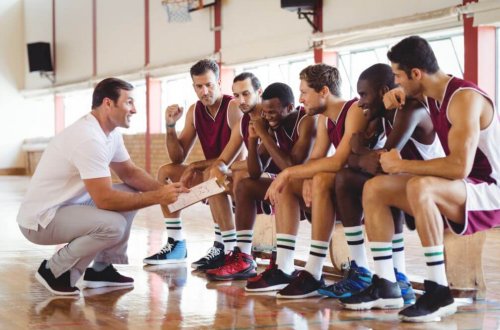Basketball Zone Defense

If you want to be a competitive basketball team in your region and category, you must learn to master zone defense. This is for those times when man to man is not enough to stop your rivals. Those moments will come without a doubt, throughout the season.
Basically it consists of not focusing on the player you face and instead, focus on a zone to guard.
In basketball, there are several kinds of zone defenses, such as 2-3, in which two players stand beyond the free shot line, while their three teammates stand parallel near the baseline.
Another example is 1-2-2 (used by Real Madrid several years ago) in which one player stands at approximately 6,75 meters, two players on the free shot line and two more a couple of meters from the baseline.

Advantages of zone defense
Zone defense is effective against the pass and go plays made by the other team. This is because your player will not follow the other player and therefore avoids defensive breakdowns.
At the same time, your basket is better guarded against short range shots.
While playing zone defense you’ll foul less and your players become less tired which makes this option an interesting strategy, especially near the end of a game.
Zone defense is effective for rebounding and stealing passes. This, in turn, gives the opportunity for fast breaks and easy layups.
Usually, guards have trouble attacking zone defenses, in contrast to the man on man, especially for those skillful, individual players.
Taller, slower players are more effective in a zone defense than playing man to man. This becomes a bulletproof trap, particularly in smaller courts.
Disadvantages of zone defense
However, not everything in this type of barricade is positive. This kind of tactic will suffer against teams with long-range shooters. It’s also a weakness against quick teams that don’t allow you to set up your defense in time.
Playing zone will weaken your player’s individual defense techniques. Your players can find it hard to be held accountable for their defensive responsibilities versus playing man to man.
As you approach the end of a game, zone defenses tend to become sloppy and abandon their positions and breakdown, especially when losing. This effect worsens if the other team passes the ball faster than your players can set up your defense.
Main principles of zone defense
When the time comes to play zone, your players must follow a set of rules to avoid your defense from crumbling.
In order to breakdown your defense, the other team’s coach will try to move the ball around quickly. He will also look for fast break points. Keeping this in mind, it’s very important that your players reach their positions in time, immediately after scoring or losing possession of the ball.
It’s essential that your players have good communication to control the opponents’ offensive moves.
Without a doubt, this is the hardest aspect to achieve for a coach. It requires constant effort and concentration from all of the players.
Your players must pay constant attention to the ball and its movements. With every pass, your players must swing to the movement without forgetting to play without the ball.
When cuts through the zone occur on the side of the ball, the cutting player must be guarded, man to man, until he is out of the zone. At that moment, your defensive player needs to get back into his position, in the zone.

Finally, to make sure your zone defense is effective, all of your players must pay close attention to the rebound. In a zone defense, it’s harder to box out than in man to man, because the players are not in constant contact with their opponents. On the other hand, rebounding is easier since not all of the other teams’ players are open.
Types of zone defense
Beyond what we have discussed, there are basically three types of zone defense:
- 2-1-2: this zone defense bases its strength on the forwards and the corners, especially rebounding. However, it’s vulnerable on the sides and the free throw line.
- 1-2-2: effective against teams with long-range shooters. Its characteristic formation allows for many pass interceptions especially if the two players inside are quick. However, its weak spot is in the corners and we will suffer if the opponent has a strong center.
- 1-3-1: this zone is mostly strong in the low post area, proving effective against teams with good low post players. The other team could also find a weakness taking shots from the corner.
If you want to be a competitive basketball team in your region and category, you must learn to master zone defense. This is for those times when man to man is not enough to stop your rivals. Those moments will come without a doubt, throughout the season.
Basically it consists of not focusing on the player you face and instead, focus on a zone to guard.
In basketball, there are several kinds of zone defenses, such as 2-3, in which two players stand beyond the free shot line, while their three teammates stand parallel near the baseline.
Another example is 1-2-2 (used by Real Madrid several years ago) in which one player stands at approximately 6,75 meters, two players on the free shot line and two more a couple of meters from the baseline.

Advantages of zone defense
Zone defense is effective against the pass and go plays made by the other team. This is because your player will not follow the other player and therefore avoids defensive breakdowns.
At the same time, your basket is better guarded against short range shots.
While playing zone defense you’ll foul less and your players become less tired which makes this option an interesting strategy, especially near the end of a game.
Zone defense is effective for rebounding and stealing passes. This, in turn, gives the opportunity for fast breaks and easy layups.
Usually, guards have trouble attacking zone defenses, in contrast to the man on man, especially for those skillful, individual players.
Taller, slower players are more effective in a zone defense than playing man to man. This becomes a bulletproof trap, particularly in smaller courts.
Disadvantages of zone defense
However, not everything in this type of barricade is positive. This kind of tactic will suffer against teams with long-range shooters. It’s also a weakness against quick teams that don’t allow you to set up your defense in time.
Playing zone will weaken your player’s individual defense techniques. Your players can find it hard to be held accountable for their defensive responsibilities versus playing man to man.
As you approach the end of a game, zone defenses tend to become sloppy and abandon their positions and breakdown, especially when losing. This effect worsens if the other team passes the ball faster than your players can set up your defense.
Main principles of zone defense
When the time comes to play zone, your players must follow a set of rules to avoid your defense from crumbling.
In order to breakdown your defense, the other team’s coach will try to move the ball around quickly. He will also look for fast break points. Keeping this in mind, it’s very important that your players reach their positions in time, immediately after scoring or losing possession of the ball.
It’s essential that your players have good communication to control the opponents’ offensive moves.
Without a doubt, this is the hardest aspect to achieve for a coach. It requires constant effort and concentration from all of the players.
Your players must pay constant attention to the ball and its movements. With every pass, your players must swing to the movement without forgetting to play without the ball.
When cuts through the zone occur on the side of the ball, the cutting player must be guarded, man to man, until he is out of the zone. At that moment, your defensive player needs to get back into his position, in the zone.

Finally, to make sure your zone defense is effective, all of your players must pay close attention to the rebound. In a zone defense, it’s harder to box out than in man to man, because the players are not in constant contact with their opponents. On the other hand, rebounding is easier since not all of the other teams’ players are open.
Types of zone defense
Beyond what we have discussed, there are basically three types of zone defense:
- 2-1-2: this zone defense bases its strength on the forwards and the corners, especially rebounding. However, it’s vulnerable on the sides and the free throw line.
- 1-2-2: effective against teams with long-range shooters. Its characteristic formation allows for many pass interceptions especially if the two players inside are quick. However, its weak spot is in the corners and we will suffer if the opponent has a strong center.
- 1-3-1: this zone is mostly strong in the low post area, proving effective against teams with good low post players. The other team could also find a weakness taking shots from the corner.
All cited sources were thoroughly reviewed by our team to ensure their quality, reliability, currency, and validity. The bibliography of this article was considered reliable and of academic or scientific accuracy.
Markazi, A., Kennedy, K., Bechtel, M., & Cannella, S. (2008). Playing Defense. Sports Illustrated. https://doi.org/10.1007/BF02212494
Annis, D. H. (2006). Optimal End-Game Strategy in Basketball. Journal of Quantitative Analysis in Sports. https://doi.org/10.2202/1559-0410.1030
Franks, A., Miller, A., Bornn, L., & Goldsberry, K. (2015). Characterizing the spatial structure of defensive skill in professional basketball. Annals of Applied Statistics. https://doi.org/10.1214/14-AOAS799
Ben Abdelkrim, N., Castagna, C., El Fazaa, S., & El Ati, J. (2010). The effect of players’ standard and tactical strategy on game demands in men’s basketball. Journal of Strength and Conditioning Research. https://doi.org/10.1519/JSC.0b013e3181e2e0a3
This text is provided for informational purposes only and does not replace consultation with a professional. If in doubt, consult your specialist.








